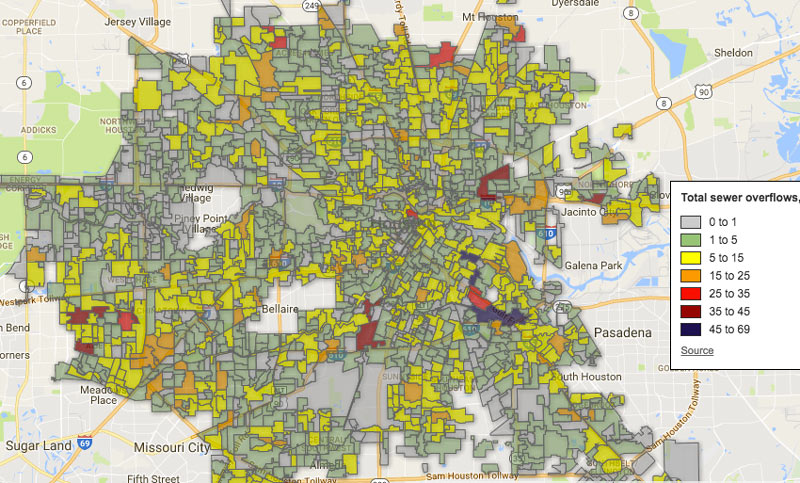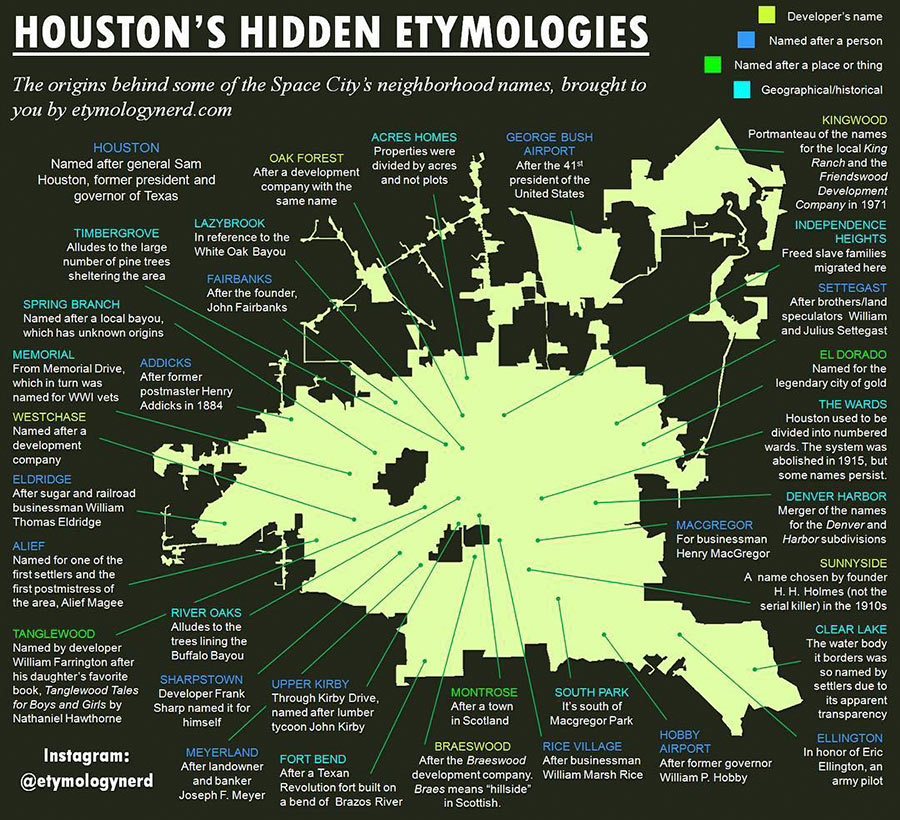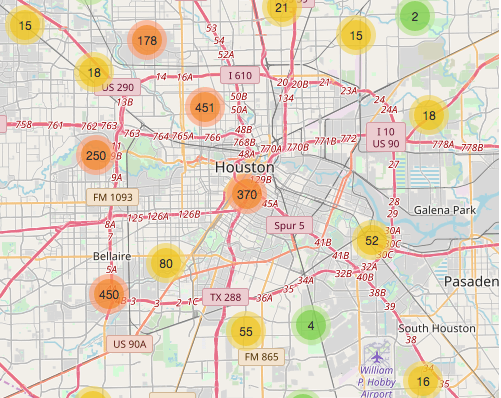The larger the dot in the interactive map above, the more frequently the surrounding ZIP code deals with sewage overflows, per to the city’s tally of sewage spills between 2009 and 2014. The map, put together by Rachael Gleason with data prepped by John Harden and Mike Morris, goes along with Morris’s update in the Chronicle this weekend on the city of Houston’s ongoing negotiations with the EPA over what to do about the city’s sewage-related water quality issues, with the estimated cost of required infrastructure upgrades and education programs on the horizon currently hanging out in the neighborhood of $5 billion dollars.
The Chronicle’s analysis also notes that most of the areas with above-average sewage spill rates are home to above-average poverty rates, as well as above-average proportions of black and Hispanic residents than the city as a whole. The map above allows readers to superimpose the spill numbers over each ZIP code’s median income and poverty rate (you’ll have to look elsewhere for maps backing up the other claim, though). Another map released earlier this summer pinpoints more precisely the spots where the sewage flows most freely — areas in purple below have seen a minimum of 45 documented sewage spills in the 5-year data period:
***

Dr. Robert Bullard of TSU points out to Morris that the neighborhoods most regularly seeing the raw sewage backups are a sort of laundry list of areas he’s focused on during his career in Houston environmental justice: “The same neighborhoods we’re talking about are the neighborhoods where, historically, services have bypassed them. This is not a new phenomenon . . . what makes it a real story is we’re talking about 2016,” Bullard tells Morris. “It reinforces this whole concept of environmental injustice and the impact of unequal distribution of resources, and the allocation of dollars based on race and class — you can predict where the worst problems are.”
- Sewer spills put city under EPA scrutiny [Houston Chronicle]
- Massive city sewer struggles will mean higher water bills [Houston Chronicle]
- Previously on Swamplot: Excessive Galveston Beach Bacteria Probably Not Leg-Threatening, Just Fecal, Say Officials; A Purple Map of Race and Public Housing Projects in HoustonSewage Now Flowing Properly Under Gulf Fwy. Again; Houston Bayous: Now Featuring Raw Sewage!
Maps: Houston Chronicle





ðŸ‘ðŸ¾ðŸ‘ðŸ¾ðŸ‘ðŸ¾ðŸ‘ðŸ¾ðŸ‘ðŸ¾ðŸ‘🾠KUDOS TO SWAMPLOT. it’s not about race! but if we’re going to discuss where BILLIONS in development are being spent, we need to also talk about the areas that get no dollars. both always have plenty to talk about! there are absolutely to many visible disparities in Houston not to have swamplot looking like it was during the oil boom with 20 articles a day! and i challenge swamplot to be BLUNT AND HONEST in the reports!
Stop the presses, are you saying crappy neighborhoods are crappy?
I’m an ultra realist, there’s not point trying to fight the tide of the ocean, learn to deal with it. Bad neighborhoods ARE bad, just move to a better one.
From an economics perspective, the s^*t flows downhill.
@commonsense: Help me understand your position. Ignoring the “just move to a better neighborhood” line as a joke, why should poor neighborhoods have worse sewers than rich neighborhoods? Why aren’t sewers maintained at the same level throughout the entire area? What could possibly justify that kind of inequality?
I think this is my favorite headline of the year. Whoever wrote it should congratulate themselves for making me laugh out some coffee.
What jumped out at me was how crappy the entire city looked on the list, regardless of whether high income or low income. Certainly some areas such as uptown and the west side that have seen more recent & rabid development show marked difference, but this just shows the whole city is a crapshoot no matter how nice your neighborhood ‘supposedly’ is.
Article aside… How did Adoile get the emotes in here? I want to do emotes….
Also, they have the count WAAAAYYY low for our area. 10 since 2016… One area of our street has overflowed out of the sewer 10 times since tax day floods. Also, this is a historically black community that it happened in and the reason that the city wont fix it is not because of racism or classism, but because they are trying to get a private home developer to do it with their money. This flooding has been going on since the mid 90s keep in mind.
@Memebag, my position is that I don’t have time or will to care ‘why’, and if I did, history shows that there’s very little that can be done. Hence logic and practicality dictates to perform an action with the quickest benefit for the least amount of effort, i.e. simply move.
@commonsense: So poor people should simply move to wealthier neighborhoods? How do they pull that off?
“Very little can be done” to prevent sewage overflows? If we have that little faith in our wastewater engineering and construction abilities, we might as well give up on this country now and try again somewhere else.
So, places like 6th ward, and Heights which are only relatively new entrants to the “poor people don’t live here” sections of town. It begs more questions. Is there data from 20 years ago? What changed in those areas other than the yearly earnings of the people that live there? Were sewers replaced as people gained more money? Is it a maintenance thing?
.
Maybe it’s the other way around. Maybe the sewer system is treated the same, but the people that live in certain economic states treat things differently? Maybe people of certain economic backgrounds instead of throwing trash in the appropriate receptacle, it’s tossed into gutters, or left in yards? Maybe it’s yard clippings and leaves that get moved by rain from yards and driveways? In rich neighborhoods I always see yard crews bagging clippings and removing them, or putting them out for pickup. In the neighborhood I live in (listed as poor above) if a yard is mowed (once a month) no one picks up the clippings, so they end up in the run off, and in the sewer.
.
Maybe it’s not an issue of government doing things differently in different areas, but people of different economic backgrounds do things differently?
@toasty
You’re talking about storm sewers. We’re talking sanitary sewers. Unless you think poor folks are more likely to flush trash down the toilet, none of what you’re talking about makes sense.
.
Why do the relatively new areas have better sewage systems? Because those areas are often improved at the beginning of the transition, often partly paid for by developers. The massive improvements done along Burnett this past year, paid for by the Hardy Yards developers, are a good example.
.
Also, I live in 4th ward, an area near the end of the transition. When I first moved in back in ’08, I had sewage back up into my downstairs bathroom about a year later, due to a blockage in the main line. Several of us complained, it was fixed, and nary a problem since. Do poor people not complain? Seems improbable, so what’s different here?
MrClean- You can put HTML in comments; the emojis are just img links.
Logo for the “commonsense” Center for Knowledge and Enlightenment:
http://wonderopolis.org/wp-content/uploads//2015/03/1425_3.jpg
@OldPostCommenter, Au Contraire, my lack of idealistic participation is not due to ‘ignoring the problem’ it’s based on the cold calculus of Game Theory, you know the stuff they teach you in Business School. I am not willing to expand time and resources to fix a problem with low probability of success, but there will always be somebody that is. If they fail, I lose nothing, if they succeed I will still reap the benefit.
@commonsense
Please ask your business school for your money back. Based on your explanation of game theory, you really deserve it.
Is anything more deceptively named than a “sanitary sewer”?
Poor = more frying
frying = grease
grease = clogged sewers
any questions?
@toasty/sylvester: it’s called blaming the victim.
Congratulations Sylvester,
It took almost 20 comments before you got it right. Hats off to you!
@sylvester: you just took me back to my college days. One of the guys I knew took great pride in his fry-daddy. Except that he decided to pour the oil down the sink…leading to the inevitable grease clog (and apartment-wide plumbing issue) by the end of the year.
lol @ commonsense. You really don’t know what you’re talking about do you? Tragedy of the commons != game theory you dolt. You should have learned how to spin BS better, because that actually IS a skill they teach in business school.
The data in the first chart would be a lot more meaningful if the sewer overflows in each zip code were calculated as an index which took into account the number of Equivalent Single-Family Connections (ESFCs) as well as the land area being served.
.
Also, why are zip codes being used to display municipal data? With the exception of Bellaire, the City of Houston’s jurisdiction doesn’t conform to the boundaries of zip codes. That means that overflow data for West U, Southside Place, the Memorial Villages, and most of the City’s peripheries is neither related to the demography of the zip codes as a whole or to the land area being depicted.
.
Valid inferences cannot reliably be drawn from this graphic.
HoustonReader: It’s called passing the blame and 0 personal responsibility.
I hate when this type of data leads to conclusions about race. It’s not about race, it’s about class. I’ll 100% agree that poor people have it bad. It sucks to be poor for many reasons. This is one of them. The fact that a higher percentage of our poor are also minorities doesn’t change the fact it’s a class issue.
.
I haven’t read all the comments but I do see Memebag… Resources should be allocate based on ‘worst first’. It’s very likely that areas of wealth are also areas of redevelopment and thus, improvement. Where as poorer areas are stagnant and don’t get the same type of improvement because there is no investment out there.
.
I know when I’ve tried to invest in a rough area, the city shit on my face. So I’ve backed down quite a bit. My guess is people smarter than me stopped well before I did.
Chris C. “@toasty You’re talking about storm sewers. We’re talking sanitary sewers. Unless you think poor folks are more likely to flush trash down the toilet, none of what you’re talking about makes sense.”
.
I hate to bring up facts, which are always called racist, but having owned property in various segments of the city, I can tell you nightmares about what’s flushed down the toilets or put down the sink in some areas vs. others. Why that is? I don’t know. But it’s a reality I promise. As a property owner, I wish it were not true.
My immigrant father told me the greatest thing is municipal water.
It is tested and guaranteed to be always potable. Wherever you go in the US!
A great society cannot exist without clean drinking water.
So the obvious corollary is that sewage must be handled effectively.
It was over 100 years ago that Houston provided sewerage … SO what the hell!!
The larger dots on the map (increased overflows) points to older, un-redeveloped neighborhoods (with respect to public infrastructure). Look carefully – at say the Heights and NW quadrant of the inner loop – for examples of where the bad thesis of “poverty/race equals more overflows” gets turned on it’s head.
Why?
Not only are newer neighborhoods blessed with newer public infrastructure (age has not crept in and heaved pipe alignments, or ancient congealed fat plugs the conveyance — but code enforced, newer water efficient plumbing fixtures are predominant in newer areas. There’s less sewerage to overwhelm a system.
It’s frustrating to see “journalists” and “professors” seeking out these questionable correlations. They should be concluding that old neighborhoods need infrastructure upgrading, and leave the race card out of it.
Before the recent rains the whole upper kirby/med center/rice village/braeswood area (nice area right?) was smelling a lot like sewage… especially around those craftily hidden “lift stations.” Ever wonder what’s being lifted? Yep. Apparently we need a few more of those, or maybe… someday… we’ll realize that humans were not meant to live like this, that density is the cause of all our problems and we’ll move out to the countryside to live in peace.